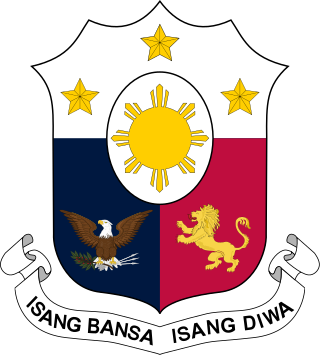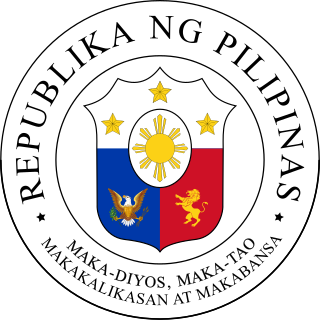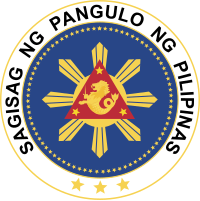
The coat of arms of the Philippines features the eight-rayed sun of the Philippines with each ray representing the eight provinces which were placed under martial law by Governor-General Ramón Blanco Sr. during the Philippine Revolution, and the three five-pointed stars representing the three major island groups of Luzon, the Visayas, and Mindanao.

The national flag of the Philippines is a horizontal bicolor flag with equal bands of royal blue and crimson red, with a white, equilateral triangle at the hoist. In the center of the triangle is a golden-yellow sun with eight primary rays, to represent the original eight provinces that rebelled against the Spanish during the 1896 Philippine Revolution. At each vertex of the triangle is a five-pointed, golden-yellow star, each of which representing one of the country's three main island groups—Luzon, Visayas, and Mindanao. The white triangle at the hoist represents liberty, equality, and fraternity. A unique feature of this flag is its usage to indicate a state of war if it is displayed with the red side on top, which is effectively achieved by flipping the flag upside-down.

The president of the Philippines is the head of state, head of government and chief executive of the Philippines. The president leads the executive branch of the Philippine government and is the commander-in-chief of the Armed Forces of the Philippines.

The Senate of the Philippines is the upper house of Congress, the bicameral legislature of the Philippines, with the House of Representatives as the lower house. The Senate is composed of 24 senators who are elected at-large under a plurality-at-large voting system.

The vice president of the Philippines is the second-highest official in the executive branch of the Philippine government and is the first in the presidential line of succession. The vice president is directly elected by the citizens of the Philippines and is one of only two nationally elected executive officials, the other being the president.

The president of the Senate of the Philippines, commonly referred to as the Senate president, is the presiding officer and the highest-ranking official of the Senate of the Philippines, and third highest and most powerful official in the government of the Philippines. They are elected by the entire body to be their leader. The Senate president is second in the line of succession to the presidency, behind only the vice president and ahead of the speaker of the House of Representatives.

The seal of the vice president of the Philippines is a symbol used to represent the history and dignity of the vice president of the Philippines. Its design was prescribed by Executive Order No. 310 of 2004, and is similar in design to the seal of the president of the Philippines.

The flag of the president of the Philippines or the presidential standard of the Philippines consists of the presidential coat of arms on a blue background. While having the same design as the presidential seal since 1947, the flag has a separate history, and the designs on the flag and seal have at different times influenced each other.
The Ang Bagong Lipunan Series is the name used to refer to Philippine banknotes and coins issued by the Central Bank of the Philippines from 1973 to 1985. It was succeeded by the New Design series of banknotes. The lowest denomination of the series is 2-piso and the highest is 100-piso.

BRP Ang Pangulo (AT-25) is a presidential yacht that was acquired by the Philippine government in 1959. The yacht was first used by President Carlos P. Garcia.

The flag of the vice president of the Philippines consists of the vice presidential coat of arms on a white background. The current flag is defined in Executive Order 310 signed by President Gloria Macapagal Arroyo:
The Flag of the Vice President of the Philippines shall consist of the Coat-of-Arms of the Vice President in proper colors, with a rectangular white background. The fringe shall be of knotted yellow silk. The ratio of the Flag shall be 1:2.

In heraldry, the term sea-lion refers to a legendary creature that has the head and upper body of a lion, but with webbed forelimbs and a fish tail. These occur most frequently as supporters, but also occur as crests and occasionally as charges. Sea-lions are frequently found in "sejant" or "sejant-erect" attitudes, but may also be found "naiant" or "assurgeant".

The Office of the President of the Philippines, is an administrative, advisory, and consultative government agency that aids the president of the Philippines in performing their duty as head of state and chief of the executive branch of government.

The Seal of Manila is composed of the city's modern coat-of-arms, with colors mirroring those of the Philippine National Flag. It is a modified form of the city's historical arms bestowed in the 16th century.

Isang Bansa, Isang Diwa was the national motto of the Philippines from 1978 to 1986, during the presidency of President Ferdinand Marcos. It was adopted on June 9, 1978 by virtue of Presidential Decree No. 1413. The motto has been criticized and has been denounced as "the slogan of a fascist regime".
Galo B. Ocampo was a Philippine artist. He was also the first Filipino to study heraldry and was a member of the International Institute of Genealogy and Heraldry in Madrid.

The Great Seal of the Philippines is used to authenticate official documents of the government of the Philippines.

The Seal of Quezon City is one of the official symbols of Quezon City. The current seal used by the city, adopted in 1975, is a triangular seal with the Quezon Memorial Shrine as its primary element.

Andres Castor Centino is a retired Philippine Army general who currently serves as Presidential Assistant on Maritime Concerns to President Bongbong Marcos since September 2023.
























